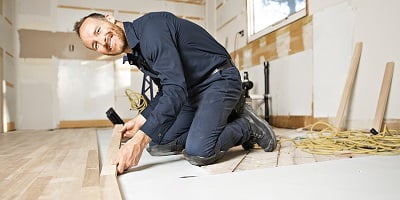Wooden floors can increase the charm and beauty of any house. However, that charm is quickly ruined when the floors start to squeak and creak. Time and wear can do a number on wooden floors, and squeaking is the floor’s way of letting you know. While many people think creaky wooden floors are inevitable after many years, squeaky floors and subfloors can be fixed with the right team and equipment.
Poor installation or maintenance practices can be to blame for squeaky floors. For folks who have squeaky wooden floors at home and don’t understand why, how to prevent them, or how to fix a squeaky floor when it occurs, keep reading. For owners of construction businesses, understanding the new tools that are available to make flooring more efficient and long-lasting can be the key to keeping your customers satisfied.
Why does the floor squeak?
Squeaky floors can happen when there’s movement somewhere in the floor. It could be that the subfloor or floorboards have moved, shifted, buckled, or come unhinged in some way. There are a variety of reasons this could happen. Let’s have a look at some of the most common reasons behind squeaky floors:
- Poor installation practices. The most important measure to take to prevent squeaky floors is to lay them right using the proper tools and installation practices. A professional contractor should be hired to prep subfloors and install wooden floors.
- The nature of wood. Although we often refer to it as hardwood, the truth is wood is a soft, porous substance that expands and contracts. Over time, subfloors and floorboards can shift and cause creaking.
- Changing temperatures. Fluctuations in temperature and drastic changes in humidity can have detrimental effects on your flooring, especially if it was not installed correctly. Wooden floors expand when the humidity rises, which is why floors are installed with gaps around the edges to allow for some swelling. However, if your floor swells beyond the gaps it can cause buckled floors or other types of damage that is difficult to fix. To avoid damage caused by shifts in temperature, you should try to maintain your home’s temperature between 60 and 80 degrees, with a relative humidity range between 35% and 55%.
- Warped floor joists. Many squeaky floors happen when the subfloor starts to separate from the floor joists, causing nails to slide in and out of the joists and creak.
Whether you’re a homeowner trying to fix a creak or the head of a construction team in charge of installing new floors, understanding what leads to creaky floors can help you avoid problems down the road. Also, using the right tools, fasteners, and practices to install new floors is crucial.
How to stop the squeak
In the past, many contractors laid floors and subfloors using traditional nails. Nails are not the best option since they are not perforated and can easily become loose and cause subflooring and floorboards to shift and jostle.
It’s recommended to use a fastener such as the SCRAIL® SubLoc® PRO. These fasteners were developed to avoid subfloor squeaks that result from micro movement of the wood. The upper threads grab into the deckboard and prevent movement, even in the event of wood shrinkage. SCRAIL® SubLoc® PRO fasteners comply with required building codes, are more durable than traditional screws and nails, and function with existing pneumatic nailers so you don’t have to buy new equipment to use them.
The entire line of SCRAIL®, developed by the BECK Group, are quickly proving to be the most innovative and useful fasteners for builders, installers, regular homeowners, and construction workers everywhere. If you’re looking for the right fasteners to repair a creaky floor or install a new one, consider SCRAIL® SubLoc® PRO today.
.svg.png)


